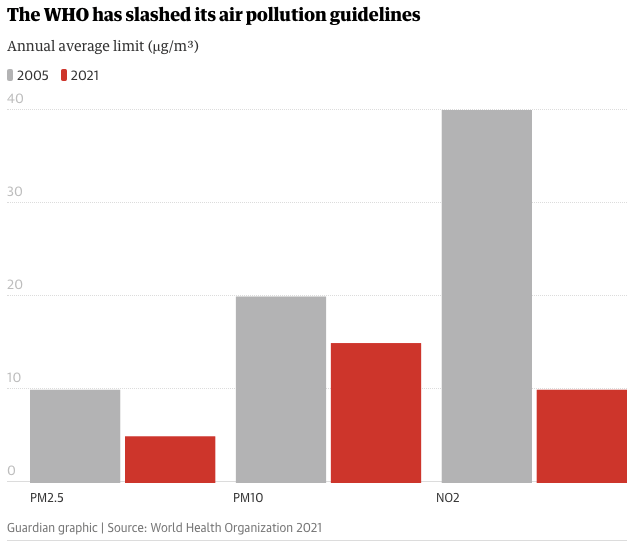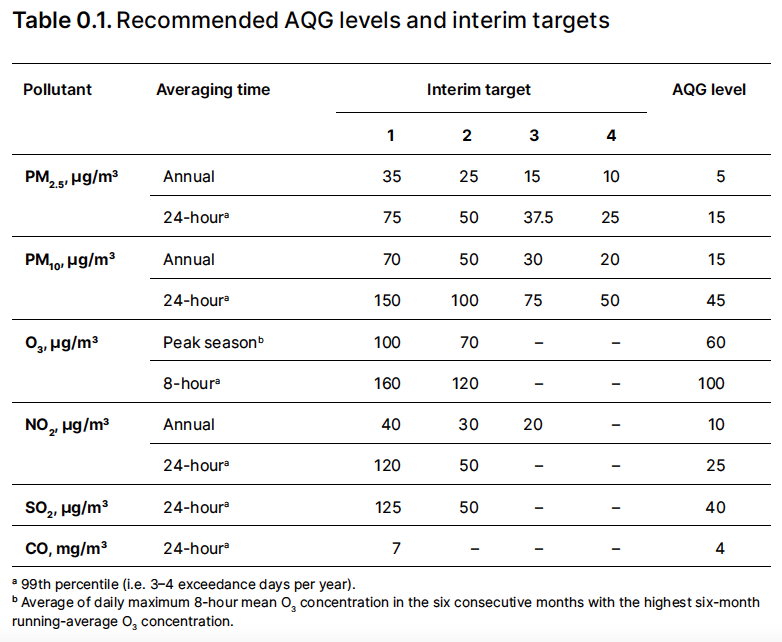

On September 22, the World Health Organization (WHO) released the latest edition of the WHO Global Air Quality Guidelines online in Geneva, the first update of the Guidelines since 2005, signaling that global air pollution is worse than expected. Over a 16-year period, the volume of evidence on the negative effects of air pollution on human health has increased significantly. Based on improved pollution measurement systems and exposure assessment systems, WHO has tightened nearly all air quality levels in the Global Air Quality Guidelines, aiming to reduce levels of key air pollutants to protect human health.
Further reductions in air pollutant levels: PM2.5 halved to 5 micrograms per cubic meter
The latest version of the Guidelines recommends new air quality standards for the main conventional pollutants that cause human health effects, including particle matter (PM2.5 and PM10) and nitrogen dioxide (NO2) (Figure 1). The latest version of the Guidelines suggests reducing the annual average concentration of PM2.5 to 5 micrograms per cubic meter, half of the 2005 recommended concentration, and PM10 from 20 to 15 micrograms per cubic meter [1]. According to the WHO, decreasing exposure to particle matter is imperative, since both forms of particulate matter can penetrate deep into the lungs and even into the bloodstream, affecting the cardiovascular and human respiratory systems. In terms of human health prevention, there is no such things as a health threshold for pollutants, and all pollutants are detrimental even if the threshold is extremely low.
Figure 1: Comparison of the air quality standards recommended in the 2005 and 2021 versions of the Global Air Quality Guidelines

In addition to the standard values, the latest version of the Guidelines includes four interim targets for PM2.5, which are intended to assist regions with excessive air pollution in assessing their progress in lowering population exposure to particulate matter over time. The target values for Stages 1 to 4 are 35, 25, 15, and 10 µg/m3 respectively, with each additional stage resulting in a reduction in mortality of approximately 7%.
Table 1: Recommended AQC levels and interim targets in the latest version of the Guidelines

WHO estimates that the number of premature deaths due to air pollution has surpassed 7 million worldwide each year. In addition to common lung and cardiovascular diseases (such as lung cancer, high blood pressure, heart disease, and stroke), air pollution affects all human organs, resulting in problems such as diabetes, dementia, mental decline and neonatal diseases. Moreover, air pollution can cause worsening of symptoms in individuals with COVID-19 infections.
The global gap in air pollution levels is widening: low-income countries are the hardest hit
While developed countries have experienced substantial improvements in air quality through years of treatment, the majority of developing countries have seen the most significant deterioration in air quality due to, among other things, massive urbanization and economic development that heavily relies on fossil fuels. According to the WHO, air pollution is the leading cause of premature deaths in low- and middle-income nations. The higher the level of exposure to air pollution, the greater the impact on human health, particularly for those with chronic illnesses, the elderly, children, and pregnant women.
In 2013, the WHO classified PM2.5 as a carcinogen. In 2019, more than ninety percent of the world's population lives in areas with PM2.5 concentrations exceeding 10 µg/m3 (Global Air Quality Guidelines 2005) [2]. According to real-time world air quality data, fewer global regions are currently able to limit PM2.5 concentrations to less than 5 µg/m3. On September 26, there are also several places in the northern European regions with high air quality where PM2.5 concentrations are above 20 µg/m3, compared to almost all cities in India where PM2.5 concentrations exceed 50 µg/m3 and most residents live in areas where PM2.5 exceeds the standard [3].
Conclusion
The latest version of the Guidelines indicates that air pollution poses a major threat to human health, as does climate change. If current air pollution levels were reduced to the levels proposed in the latest Guidelines, approximately 80 percent of PM2.5-related fatal diseases may be prevented worldwide. This new version of the Guidelines, released just one month before the United Nations Climate Change Conference in Glasgow (COP26), is designed to draw the attention of heads of state to the dangers posed by fossil fuel combustion, ecological overexploitation, and climate change-induced air pollution. Although the Guidelines are not legally binding, they can serve as a significant basis for governments to develop legislation and policies to enhance global air quality and lessen the massive burden of air pollution on human health.
Note:
[1] WHO, Global Air Quality Guidelines, Link: https://apps.who.int/iris/bitstream/handle/10665/345329/9789240034228-eng.pdf?sequence=1&isAllowed=y
[2] WHO, Ambient (outdoor) air pollution, Link: https://www.who.int/news-room/fact-sheets/detail/ambient-(outdoor)-air-quality-and-health
[3] World Air Quality Index, Link: https://waqi.info/cn/#/c/22.458/82.786/5.7z
Author: Yuan Yating
Translation: Duan Yuxuan
Proofread: Yuan Yating
This article is an original article of the Rock Environment and Energy Institute. Please contact us to obtain the appropriate authorization to reprint. For cooperation and authorization, please send an email to: liying@reei.org.cn
* This is the translation of an article in Chinese. Should there be any inconsistency between Chinese and English version, the Chinese version shall prevail.




